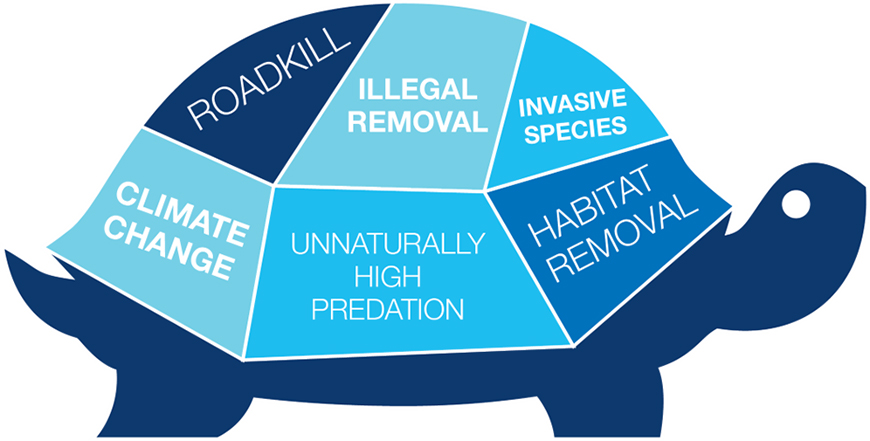Strategic environmental assessments
Transcript
Parks Canada has a robust framework in place to assess the impact of project proposals on national parks. One of the trickier aspects of impact assessment is cumulative effects.
A cumulative effect occurs when multiple projects or activities impact a single component of the ecosystem. Parks Canada uses a layered approach to impact assessment to help us keep the big picture cumulative effects in mind while focusing on the details when we need to identify mitigations for a project.
Let’s look at how cumulative effects can be dangerous for turtles, and how they are assessed. The big picture is analyzed through a strategic environmental assessment of the national park management plan. For example, the strategic assessment would consider how a warmer climate may reduce the extent of wetland habitat available to turtles. Meanwhile, analysis may show increases in turtles being taken illegally for the pet trade. Unnaturally high predation or invasive species can also hurt the turtle population.
When a project is proposed, the impact assessment would consider that turtles can be hit and killed by vehicles on the road...and shoreline work could interrupt turtles’ access to their nesting habitat. We want to minimize cumulative effects so we use this layered approach to make sure the impact assessment from each project more easily incorporates the big picture vision of cumulative effects. In this way, we ensure projects don’t impact our ability to maintain or restore ecological integrity.
To learn more visit pc.gc.ca.
Parks Canada uses two layers of impact assessment. Project-level assessments are one layer. The other layer is strategic environmental assessment (SEA). This layered system is part of a robust framework to assess the impact of project proposals on national parks, marine conservation areas and historic sites. The framework ensures that ecological integrity, ecological sustainability and commemorative integrity are protected. Protection of heritage areas is what enables Parks Canada to provide meaningful services and experiences to visitors.
Understanding cumulative effects
Project-level impact assessments are necessary. But they are not always the right tool to identify broader cumulative effects. A cumulative effect occurs when multiple human actions combine to have a negative impact on the environment. Other external factors like climate change may also contribute to the effect. To understand cumulative effects, we need to view the environment through a wider lens than a project-level assessment.
For example, turtles can be impacted by multiple human actions within one park. Turtles can be hit and killed by vehicles on the road. Some might be taken illegally for the pet trade. A shoreline project could interrupt turtles’ access to their nesting habitat. Meanwhile, a warmer climate may reduce the extent of wetland habitat available to turtles. The combined impact of all these concurrent stressors is a cumulative effect on turtles.

-
Cumulative effects: long text description
This image shows a drawing of a turtle whose shell is labeled with various cumulative effects: roadkill, climate change, illegal removal, unnaturally high predation, invasive species, habitat removal.
Strategic environmental assessment enables Parks Canada to consider this big-picture view. It is applied to policies, plans and programs. For example, we do strategic environmental assessment on all 10-year national park, national marine conservation area and national urban park management plans. This allows us to evaluate cumulative effects over a region. We identify the gaps in our knowledge, and the methods and tools needed to manage cumulative effects. The process can also uncover opportunities to boost positive effects. The findings of strategic environmental assessment are used to ensure that project-level assessment is effective. A summary of the strategic environmental assessment is included in the management plan.
Managing cumulative effects at Parks Canada (PDF, 1.41 MB)
You can find copies of some of the strategic environmental assessments on Open Government.
Statements on strategic environmental assessment
Parks Canada provides a public statement that summarizes the strategic environmental assessment when a proposal is approved. The assessment itself may be documented in a stand-alone report, or it may be incorporated into the assessed policy, plan or program.
- Date modified :